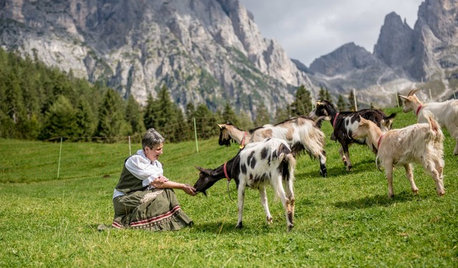Italian Honey
tandrew31
14 years ago
Related Stories

FARM YOUR YARDHello, Honey: Beekeeping Anywhere for Fun, Food and Good Deeds
We need pollinators, and they increasingly need us too. Here, why and how to be a bee friend
Full Story
FARMHOUSESWorld of Design: See How 9 Families Live and Farm on Their Land
Join us as we visit the homes and farms of passionate food producers and hear about rural life around the globe
Full Story
FRONT YARD IDEAS10 Ideas for a Front-Yard Edible Garden Your Neighbors Will Love
Choosing attractive, well-mannered plants and sharing the bounty will go a long way toward keeping the peace
Full Story
KITCHEN DESIGNKitchen of the Week: Elegant Updates for a Serious Cook
High-end appliances and finishes, and a more open layout, give a home chef in California everything she needs
Full Story
LIFEHow Do You Make Your Tea and Coffee in the Morning?
A morning cup is a must for many, and preparation comes in many guises. We look at coffee and tea habits across the Houzz community
Full Story
MATERIALSKitchen Ideas: How to Choose the Perfect Backsplash
Backsplashes not only protect your walls, they also add color, pattern and texture. Find out which material is right for you
Full Story
KITCHEN DESIGN9 Kitchen Color Ideas With Staying Power
Stick to these classic color combinations for a kitchen that will never go out of style
Full Story
LANDSCAPE DESIGNEnergy Now: Designing a Garden That Gets You Going
Serenity has its place, but a garden that recharges and motivates you can be a beautiful thing
Full Story
GREAT HOME PROJECTSUpgrade Your House With New Interior Doors
New project for a new year: Enhance your home's architecture with new interior doors you'll love to live with every day
Full StoryMore Discussions







paully22
vern_2006
Related Professionals
Middle Island Landscape Architects & Landscape Designers · Lyndhurst Landscape Contractors · Mount Sinai Landscape Contractors · Selden Landscape Contractors · Watertown Landscape Contractors · Wayland Landscape Contractors · Salisbury Decks, Patios & Outdoor Enclosures · Coral Gables Fence Contractors · Fullerton Fence Contractors · Gardena Fence Contractors · Orlando Fence Contractors · Pensacola Fence Contractors · Piedmont Fence Contractors · Salt Lake City Fence Contractors · Silver Spring Fence Contractorsdanab_z9_la
fignut
danab_z9_la
paully22
peg919
herman2_gw
danab_z9_la
rafed
peg919
cath41
fredfig
eukofios
herman2_gw
eukofios
danab_z9_la
igo4fish
janejoe1_comcast_net
igo4fish
bouttyme